Dielectric Strength of Polymeric Solid–Solid Interfaces under Dry-Mate and Wet-Mate Conditions
Abstract
:1. Introduction
2. Interfaces in State-of-the-Art Cable Connectors
2.1. Interfaces in Subsea Cable Connections
2.2. Interfaces in Polymer-Insulated Cable Connections
2.3. Factors Affecting the Interfacial Breakdown Strength
- Surface roughness;
- Contact force;
- Mechanical and electrical characteristics of the insulation materials, such as elasticity and tracking resistance;
- Surrounding/insulating dielectric medium; and
- Care exercised and conditions during assembly.
2.4. Contact Surfaces at Solid–Solid Interfaces
3. Empirical Studies on Dielectric Strength of Polymers and Solid–Solid Interfaces
3.1. Studies on the Insulation Properties of Polymers
3.2. Studies on the Dielectric Strength of Solid–Solid Interfaces
3.2.1. Studies with a Focus on Electrical Breakdown
3.2.2. Studies with a Focus on Partial Discharges
3.2.3. Studies with a Focus on Interfacial Discharge Monitoring
4. Theoretical Studies on Contact Surface Modeling Using Tribology
4.1. Constituents of Contact Spots in Fractal Dimensions
4.2. Statistical Interface Contact Models
4.3. Deterministic Interface Contact Models
5. Concluding Remarks
- The findings from experimental and theoretical studies indicate that different processes control the discharge of air-filled cavities and the breakdown of contact spots. The main conclusion is that the properties of the cavities and contact spots govern the interface breakdown. On the one hand, the size, shape, and insulating medium inside the cavities determine the discharge inception field of the cavities. On the other hand, the tracking resistance of the contact spots between the discharged cavities heavily affects the interfacial breakdown strength. Different tracking resistances of the polymers tend to affect the primary discharge propagation mechanisms of particle bombardment and the light emission from the discharge channel. In contrast, the charge injection, trapping, and de-trapping mechanisms have indirect effects as they result in more intense light emission and local field distortion in the initiation stage.
- The breakdown strengths of the dry-mate interfaces are found to be the highest in the cases where the contact pressure is relatively high, and the interface is as smooth as possible. Consequently, solid–solid interfaces can be made to perform better by introducing a smoother surface and sustaining the interface pressure to be high enough throughout the service life.
- Air-filled (dry-mate) cavities and water-filled (wet-mate) cavities yield breakdown strength values that are significantly lower than those in the case of oil-mate interfaces. Strong local field stresses arising at the edges of the contact area (due to short-circuited/discharged cavities) dramatically reduce the overall breakdown strength when water is present at an interface. Hence, water intrusion is a serious concern in the design of any HV equipment incorporating solid–solid interfaces.
- The surface roughness has a significant influence on the interfacial breakdown strength. A high correlation between the interfacial breakdown strength and the surface roughness is found. The breakdown strength may potentially become twice as high from the roughest to the smoothest surface.
- The elastic modulus stands out as an important material property for solid materials/interfaces because it strongly impacts the interfacial dielectric strength. Specifically, softer materials with low elastic moduli, such as SiR and XLPE, have a much higher breakdown strength when compared with stiffer materials with high elastic moduli.
- Increased contact pressure yields higher BDS values irrespective of the surface roughness and elasticity, where elasticity can be a limiting factor in elastic contacts. In plastic contacts, the real area of contact does not increase even if the contact pressure is further increased.
- Considering practical power cables and connectors, avoiding the loss of interfacial pressure between solid materials and water ingress appears to be of considerable value in practical applications to ensure a high breakdown strength and long service life.
Funding
Institutional Review Board Statement
Informed Consent Statement
Data Availability Statement
Conflicts of Interest
References
- Kunze, D.; Parmigiani, B.; Schroth, R.; Gockenbach, E. Macroscopic Internal Interfaces in High Voltage Cable Accessories; CIGRE Session: Paris, France, 2000; pp. 15–203. [Google Scholar]
- Siemens. Spectron. Available online: https://assets.siemens-energy.com/siemens/assets/api/uuid:e0e64e11-b801-4629-9f0f-50cd0c544f6f/spectronbrochure.pdf (accessed on 30 November 2021).
- Midttveit, S.; Monsen, B.; Frydenlund, S.; Stenevik, K. SS on Implications of subsea processing power distribution-subsea power systems—A key enabler for subsea processing. In Proceedings of the Offshore Technology Conference, Houston, TX, USA, 3–6 May 2010. [Google Scholar]
- Weiss, P.; Beurthey, S.; Chardard, Y.; Dhedin, J.; Andre, T.; Rabushka, K.; Tourcher, C.; Gauch, F.; Micoli, C. Novel wet-mate connectors for high voltage and power transmissions of ocean renewable energy systems. In Proceedings of the 4th International Conference on Ocean Energy, Dublin, Ireland, 17–19 October 2012. [Google Scholar]
- ∅stergaard, I.; Nysveen, A.; Romanisko, T. MECON: A High Voltage Subsea Connector. In Proceedings of the Offshore Technology Conference, Houston, TX, USA, 3–6 May 1999. [Google Scholar] [CrossRef]
- Myklatun, J.T. Condition Monitoring of Subsea Connectors. Master’s Thesis, Norwegian University of Science and Technology, Trondheim, Norway, 2014. [Google Scholar]
- Nysveen, A. Coupling-and Switch System for Subsea Electrical Power Distribution. U.S. Patent 5834721, 22 May 1998. [Google Scholar]
- Peschke, E.; von Olshausen, R. Cable Systems for High and Extra-High Voltage: Development, Manufacture, Testing, Installation and Operation of Cables and Their Accessories; Wiley-VCH: Hoboken, NJ, USA, 1999. [Google Scholar]
- Argaut, P.; Becker, J.; Dejean, P.M.; Sin, S.; Dorison, E. Studies and Development in France of 400 kV Cross-Linked Polyethylene Cable Systems; CIGRE Session: Paris, France, 2000; pp. 15–203. [Google Scholar]
- Argaut, P. (Ed.) Accessories for HV and EHV Extruded Cables; CIGRE Green Books; Springer: Berlin/Heidelberg, Germany, 2021. [Google Scholar]
- Hasheminezhad, S.M. Tangential Electric Breakdown Strength and PD Inception Voltage of Solid-Solid Interface. Ph.D. Thesis, Norwegian University of Science and Technology, Trondheim, Norway, 2016. [Google Scholar]
- Bogoeva-Gaceva, G.; Dimeski, D.; Srebrenkoska, V. Friction Mechanism of Polymers and Their Composites. Maced. J. Chem. Chem. Eng. 2018, 37, 1–11. [Google Scholar] [CrossRef]
- Takahashi, T.; Okamoto, T.; Ohki, Y.; Shibata, K. Breakdown strength at the interface between epoxy resin and silicone rubber—A basic study for the development of all solid insulation. IEEE Trans. Dielectr. Electr. Insul. 2005, 12, 719–724. [Google Scholar] [CrossRef]
- Fournier, D.; Dang, C.; Paquin, L. Interfacial breakdown in cable joints. In Proceedings of the 1994 IEEE International Symposium on Electrical Insulation, Pittsburgh, PA, USA, 5–8 June 1994; pp. 450–452. [Google Scholar] [CrossRef]
- Fournier, D.; Lamarre, L. Interfacial breakdown phenomena between two EPDM surfaces. In Proceedings of the Sixth International Conference on Dielectric Materials, Measurements and Applications, Manchester, UK, 7–10 September 1992; pp. 330–333. [Google Scholar]
- Fournier, D. Effect of the surface roughness on interfacial breakdown between two dielectric surfaces. In Proceedings of the Montreal, Montreal, QC, Canada, 16–19 June 1996; Volume 2, pp. 699–702. [Google Scholar]
- Du, B.; Gu, L. Effects of interfacial pressure on tracking failure between XLPE and silicon rubber. IEEE Trans. Dielectr. Electr. Insul. 2010, 17, 1922–1930. [Google Scholar] [CrossRef]
- Du, B.; Zhu, X.; Gu, L.; Liu, H. Effect of surface smoothness on tracking mechanism in XLPE-Si-rubber interfaces. IEEE Trans. Dielectr. Electr. Insul. 2011, 18, 176–181. [Google Scholar] [CrossRef]
- Dissado, L.A.; Fothergill, J.C. Electrical Degradation and Breakdown in Polymers; IET: London, UK, 1992; Volume 9. [Google Scholar]
- Bhushan, B. Contact mechanics of rough surfaces in tribology: Multiple asperity contact. Tribol. Lett. 1998, 4, 1–35. [Google Scholar] [CrossRef]
- Bhushan, B.; Tian, X. A numerical three-dimensional model for the contact of rough surfaces by variational principle. ASME J. Tribol 1996, 118, 33–42. [Google Scholar]
- CIGRE Technical Brochure 210. Joint Task Force 21/15: Interface in Accessories for Extruded HV and EHV Cables; CIGRE: Paris, France, 2002. [Google Scholar]
- Albayrak, S.; Becker-Willinger, C.; Aslan, M.; Veith, M. Influence of nano-scaled zirconia particles on the electrical properties of polymer insulating materials. IEEE Trans. Dielectr. Electr. Insul. 2012, 19, 76–82. [Google Scholar] [CrossRef]
- Roy, M.; Nelson, J.K.; MacCrone, R.K.; Schadler, L.S.; Reed, C.W.; Keefe, R. Polymer nanocomposite dielectrics-the role of the interface. IEEE Trans. Dielectr. Electr. Insul. 2005, 12, 629–643. [Google Scholar] [CrossRef]
- Ding, H.Z.; Varlow, B.R. Effect of nano-fillers on electrical treeing in epoxy resin subjected to AC voltage. In Proceedings of the 17th Annual Meeting of the IEEE Lasers and Electro-Optics Society, Boulder, CO, USA, 20 October 2004; pp. 332–335. [Google Scholar]
- Li, J.; Du, B.X.; Xu, H. Suppressing interface charge between LDPE and EPDM for HVDC cable accessory insulation. IEEE Trans. Dielectr. Electr. Insul. 2017, 24, 1331–1339. [Google Scholar] [CrossRef]
- Du, B.X.; Li, J. Interface charge behaviors between LDPE and EPDM filled with carbon black nanoparticles. IEEE Trans. Dielectr. Electr. Insul. 2016, 23, 3696–3703. [Google Scholar] [CrossRef]
- Du, B.X.; Xu, H.; Li, J. Effects of mechanical stretching on space charge behaviors of PP/POE blend for HVDC cables. IEEE Trans. Dielectr. Electr. Insul. 2017, 24, 1438–1445. [Google Scholar] [CrossRef]
- Huuva, R.; Englund, V.; Gubanski, S.M.; Hjertberg, T. A versatile method to study electrical treeing in polymeric materials. IEEE Trans. Dielectr. Electr. Insul. 2009, 16, 171–178. [Google Scholar] [CrossRef]
- Chen, X.; Xu, Y.; Cao, X.; Gubanski, S.M. Electrical treeing behavior at high temperature in XLPE cable insulation samples. IEEE Trans. Dielectr. Electr. Insul. 2015, 22, 2841–2851. [Google Scholar] [CrossRef]
- Fothergill, J.C. Filamentary electromechanical breakdown. IEEE Trans. Electr. Insul. 1991, 26, 1124–1129. [Google Scholar] [CrossRef]
- Eichhorn, R.M. Treeing in Solid Extruded Electrical Insulation. IEEE Trans. Electr. Insul. 1977, EI-12, 2–18. [Google Scholar] [CrossRef]
- Mason, J.H. Assessing the resistance of polymers to electrical treeing. IEE Proc. A Phys. Sci. Meas. Instrum. Manag. Educ. Rev. 1981, 128, 193–201. [Google Scholar] [CrossRef]
- Roseen, P.A.; Gubanski, S.M.; Gedde, U.W. External PD resistance of thermoplastic and XLPE containing voltage stabilizers. IEEE Trans. Dielectr. Electr. Insul. 1998, 5, 189–194. [Google Scholar] [CrossRef]
- Hammarström, T.J.Å.; Bengtsson, T.; Gubanski, S.M. Partial discharge characteristics of electrical treeing in XLPE insulation exposed to voltages of different rise times. In Proceedings of the 2017 International Symposium on Electrical Insulating Materials (ISEIM), Toyohashi, Japan, 11–15 September 2017; Volume 1, pp. 407–410. [Google Scholar] [CrossRef]
- Chen, X.; Murdany, D.; Liu, D.; Andersson, M.; Gubanski, S.M.; Gedde, U.W.; Suwarno. AC and DC pre-stressed electrical trees in LDPE and its aluminum oxide nanocomposites. IEEE Trans. Dielectr. Electr. Insul. 2016, 23, 1506–1514. [Google Scholar] [CrossRef]
- Chen, X.; Xu, Y.; Cao, X.; Gubanski, S.M. On the conducting and non-conducting electrical trees in XLPE cable insulation specimens. IEEE Trans. Dielectr. Electr. Insul. 2016, 23, 95–103. [Google Scholar] [CrossRef]
- Zheng, Y.; Serdyuk, Y.V.; Gubanski, S.M. Space charge controlled electric field preceding inception of electric tree in XLPE at AC voltage. In Proceedings of the 2015 IEEE 11th International Conference on the Properties and Applications of Dielectric Materials (ICPADM), Sydney, NSW, Australia, 19–22 July 2015; pp. 132–135. [Google Scholar] [CrossRef]
- Jarvid, E.M.; Johansson, A.B.; Blennow, J.H.M.; Andersson, M.R.; Gubanski, S.M. Evaluation of the performance of several object types for electrical treeing experiments. IEEE Trans. Dielectr. Electr. Insul. 2013, 20, 1712–1719. [Google Scholar] [CrossRef]
- Chen, X.R.; Hu, L.B.; Xu, Y.; Cao, X.L.; Gubanski, S.M. Investigation of temperature effect on electrical trees in XLPE cable insulation. In Proceedings of the 2012 Annual Report Conference on Electrical Insulation and Dielectric Phenomena, Montreal, QC, Canada, 14–17 October 2012; pp. 612–615. [Google Scholar] [CrossRef]
- Jarvid, M.; Johansson, A.; Englund, V.; Gubanski, S.; Andersson, M.R. Electrical tree inhibition by voltage stabilizers. In Proceedings of the 2012 Annual Report Conference on Electrical Insulation and Dielectric Phenomena, Montreal, QC, Canada, 14–17 October 2012; pp. 605–608. [Google Scholar] [CrossRef]
- Sonerud, B.; Blennow, J.; Gubanski, S.M.; Nilsson, S.; Bengtsson, T. Continuous monitoring of dielectric properties of LDPE samples during electrical treeing. In Proceedings of the 2010 10th IEEE International Conference on Solid Dielectrics, Potsdam, Germany, 4–9 July 2010; pp. 1–4. [Google Scholar] [CrossRef]
- Roseen, P.A.; Reitberger, T.; Gubanski, S.M.; Gedde, U.W. PD resistance of thermally aged polyethylene and carbonyl-containing model polymers. IEEE Trans. Dielectr. Electr. Insul. 1999, 6, 191–201. [Google Scholar] [CrossRef]
- Dang, C.; Fournier, D. Dielectric performance of interfaces in premolded cable joints. IEEE Tran. Power Deliv. 1997, 12, 29–32. [Google Scholar] [CrossRef]
- Fournier, D.; Lamarre, L. Effect of pressure and length on interfacial breakdown between two dielectric surfaces. In Proceedings of the Conference Record of the 1992 IEEE International Symposium on Electrical Insulation, Baltimore, MD, USA, 7–10 June 1992; pp. 270–272. [Google Scholar] [CrossRef]
- Fournier, D.; Lamarre, L. Effect of pressure and temperature on interfacial breakdown between two dielectric surfaces. In Proceedings of the 1992 Annual Report: Conference on Electrical Insulation and Dielectric Phenomena, Victoria, BC, Canada, 18–21 October 1992; pp. 229–235. [Google Scholar]
- Kantar, E.; Mauseth, F.; Ildstad, E. Effect of pressure and elastic modulus on tangential breakdown strength of solid-solid interfaces. In Proceedings of the 2016 IEEE Electrical Insulation Conference (EIC), Montreal, QC, Canada, 19–22 June 2016; pp. 431–435. [Google Scholar] [CrossRef]
- Kantar, E.; Panagiotopoulos, D.; Ildstad, E. Factors Influencing the Tangential AC Breakdown Strength of Solid-Solid Interfaces. IEEE Trans. Dielectr. Electr. Insul. 2016, 23, 1778–1788. [Google Scholar] [CrossRef] [Green Version]
- Kunze, D. Untersuchungen an Grenzflächen Zwischen Polymerwerkstoffen Unter Elektrischer Hochfeldbeanspruchung in der Garniturentechnik VPE-Isolierter Hochspannungskabel; Shaker: Düren, Germany, 2000. [Google Scholar]
- Du, B.; Gu, L.; Zhang, X.; Zhu, X. Fundamental research on dielectric breakdown between XLPE and silicon rubber interface in HV cable joint. In Proceedings of the 2009 IEEE 9th International Conference on the Properties and Applications of Dielectric Materials, Harbin, China, 19–23 July 2009; pp. 97–100. [Google Scholar]
- Chen, X.; Gu, L.; He, X.; Liao, H. Tracking failure process of XLPE–Silicone rubber interface under impulse voltage. In Proceedings of the 2012 International Conference on High Voltage Engineering and Application, Shanghai, China, 17–20 September 2012; pp. 51–54. [Google Scholar]
- Hasheminezhad, M.; Ildstad, E. Application of contact analysis on evaluation of breakdown strength and PD inception field strength of solid-solid interfaces. IEEE Trans. Dielectr. Electr. Insul. 2012, 19, 1–7. [Google Scholar] [CrossRef]
- Hasheminezhad, M.; Ildstad, E. Partial discharge inception of interface voids versus mechanical surface pressure. In Proceedings of the 2010 International Conference on High Voltage Engineering and Application, New Orleans, LA, USA, 11–14 October 2010; pp. 397–400. [Google Scholar] [CrossRef]
- Hasheminezhad, S.M.; Ildstad, E.; Nysveen, A. Breakdown strength of solid-solid interface. In Proceedings of the 2010 10th IEEE International Conference on Solid Dielectrics, Potsdam, Germany, 4–9 July 2010; pp. 1–4. [Google Scholar] [CrossRef] [Green Version]
- Hasheminezhad, S.M. Breakdown strength of solid | solid interfaces. In Proceedings of the Trondheim PowerTech, Trondheim, Norway, 19–23 June 2011; pp. 1–7. [Google Scholar]
- Hasheminezhad, M.; Ildstad, E. Breakdown strength of solid-solid interfaces. In Proceedings of the Nordic Insulation Symposium (NORD-IS), Trondheim, Norway, 9–12 June 2011. [Google Scholar]
- Kantar, E.; Ildstad, E. Modeling longitudinal breakdown strength of solid-solid interfaces using contact theory. In Proceedings of the 2016 IEEE International Conference on Dielectrics (ICD), Montpellier, France, 3–7 July 2016; Volume 1, pp. 398–401. [Google Scholar] [CrossRef]
- Kantar, E.; Hvidsten, S.; Mauseth, F.; Ildstad, E. On the Tangential AC Breakdown Strength of Polymeric Interfaces Considering Elastic Modulus. In Proceedings of the 2017 IEEE Conference on Electrical Insulation and Dielectric Phenomenon (CEIDP), Fort Worth, TX, USA, 22–25 October 2017; pp. 816–819. [Google Scholar] [CrossRef] [Green Version]
- Kantar, E.; Hvidsten, S.; Mauseth, F.; Ildstad, E. Tangential AC Breakdown Strength of Solid-Solid Interfaces Considering Surface Roughness. In Proceedings of the 2017 IEEE Conference on Electrical Insulation and Dielectric Phenomenon (CEIDP), Fort Worth, TX, USA, 22–25 October 2017; pp. 580–583. [Google Scholar] [CrossRef] [Green Version]
- Kantar, E.; Hvidsten, S.; Mauseth, F.; Ildstad, E. Longitudinal AC Breakdown Voltage of XLPE-XLPE Interfaces Considering Surface Roughness and Pressure. IEEE Trans. Dielectr. Electr. Insul. 2017, 24, 3047–3054. [Google Scholar] [CrossRef] [Green Version]
- Kantar, E.; Hvidsten, S.; Ildstad, E. Effect of Material Elasticity on the Longitudinal AC Breakdown Strength of Solid-Solid Interfaces. IEEE Trans. Dielectr. Electr. Insul. 2019, 26, 655–663. [Google Scholar] [CrossRef]
- Kantar, E.; Hvidsten, S.; Mauseth, F.; Ildstad, E. A Stochastic Model for Contact Surfaces at Polymer Interfaces Subjected to an Electrical Field. Tribol. Int. 2018, 127, 361–371. [Google Scholar] [CrossRef]
- Kantar, E. Mechanisms Governing Longitudinal AC Breakdown at Solid-Solid Interfaces. In Proceedings of the 2020 IEEE Conference on Electrical Insulation and Dielectric Phenomena (CEIDP), East Rutherford, NJ, USA, 18–30 October 2020; pp. 279–283. [Google Scholar] [CrossRef]
- Du, B.X.; Ma, Z.L.; Cheng, X.X.; Liu, Y. Hydrophobicity evaluation of silicone rubber insulator using PD-induced electromagnetic wave. IEEE Trans. Dielectr. Electr. Insul. 2012, 19, 1060–1067. [Google Scholar] [CrossRef]
- Illias, H.A. Measurement and Simulation of Partial Discharges within a Spherical Cavity in a Solid Dielectric Material. Ph.D. Thesis, University of Southampton, Southampton, UK, 2011. [Google Scholar]
- Illias, H.; Chen, G.; Lewin, P.L. Modeling of partial discharge activity in spherical cavities within a dielectric material. IEEE Electr. Insul. Mag. 2011, 27, 38–45. [Google Scholar] [CrossRef]
- Illias, H.; Yuan, T.S.; Mokhlis, H.; Chen, G.; Lewin, P.L. Partial discharge patterns in high voltage insulation. In Proceedings of the 2012 IEEE International Conference on Power and Energy (PECon), Kota Kinabalu, Malaysia, 2–5 December 2012; pp. 750–755. [Google Scholar]
- Adhikari, D.; Hepburn, D.M.; Stewart, B.G. PD characteristics and degradation in PET insulation with vented and unvented internal voids. Electr. Power Syst. Res. 2013, 100, 65–72. [Google Scholar] [CrossRef]
- Adhikari, D.; Hepburn, D.M.; Stewart, B.G. Analysis of partial discharge characteristics in artificially created voids. In Proceedings of the 45th International Universities Power Engineering Conference UPEC2010, Cardiff, UK, 31 August–3 September 2010; pp. 1–4. [Google Scholar]
- Mas’ud, A.A.; Stewart, B.G. An investigative study on the influence of correlation of PD statistical features on PD pattern recognition. In Proceedings of the 2018 IEEE 2nd International Conference on Dielectrics (ICD), Budapest, Hungary, 1–5 July 2018; pp. 1–5. [Google Scholar] [CrossRef]
- Mohamed, F.P.; Siew, W.H.; Sheng, B.; Stewart, B. Effect of voltage reduction in minimising partial discharge activity in cables—Experimental study. In Proceedings of the 2017 IEEE Conference on Electrical Insulation and Dielectric Phenomenon (CEIDP), Fort Worth, TX, USA, 22–25 October 2017; pp. 331–334. [Google Scholar] [CrossRef]
- Adhikari, D.; Hepburn, D.M.; Stewart, B.G. Comparison of partial discharge characteristics and degradation in several polymeric insulators. IET Sci. Meas. Tech. 2012, 6, 474–484. [Google Scholar] [CrossRef]
- Reid, A.J.; Hepbum, D.M.; Stewart, B.G. The influence of external magnetic fields on the partial discharge characteristics of voids. In Proceedings of the 2013 IEEE Electrical Insulation Conference (EIC), Ottawa, ON, Canada, 2–5 June 2013; pp. 147–150. [Google Scholar] [CrossRef]
- Kantar, E.; Hvidsten, S. A deterministic breakdown model for dielectric interfaces subjected to tangential electric field. J. Phys. D Appl. Phys. 2021, 54, 295503. [Google Scholar] [CrossRef]
- Gu, L.; He, X. Microcavity on tracking failure of XLPE-SiR interface. In Proceedings of the 2012 Asia-Pacific Power and Energy Engineering Conference, Shanghai, China, 27–29 March 2012; pp. 1–4. [Google Scholar]
- Kantar, E.; Ildstad, E. A Novel Methodology to Monitor Partial Discharges in Microvoids at Solid-Solid Interfaces. In Proceedings of the 2019 IEEE Conference on Electrical Insulation and Dielectric Phenomena (CEIDP), Richland, WA, USA, 20–23 October 2019; pp. 113–117. [Google Scholar] [CrossRef] [Green Version]
- Kato, M.; Nishimura, Y.; Osawa, N.; Yoshioka, Y.; Yanase, H.; Okamoto, K. Effects of Compressive Force and Dielectric Materials on Contact Area for High-Pressure Region and Interfacial AC Breakdown between Two Solid Dielectrics. In Proceedings of the 21st International Symposium on High Voltage Engineering (ISH 2019), Budapest, Hungary, 26–30 August 2019; pp. 118–129. [Google Scholar] [CrossRef]
- Kantar, E. Longitudinal AC Electrical Breakdown Strength of Polymer Interfaces. Ph.D. Thesis, Norwegian University of Science and Technology, Trondheim, Norway, 2019. [Google Scholar]
- Gao, Y.; Yuan, Y.; Chen, L.; Li, J.; Huang, S.; Du, B. Direct Fluorination Induced Variation in Interface Discharge Behavior between Polypropylene and Silicone Rubber Under AC Voltage. IEEE Access 2018, 6, 23907–23917. [Google Scholar] [CrossRef]
- Dissado, L.A. Understanding electrical trees in solids: From experiment to theory. IEEE Trans. Dielectr. Electr. Insul. 2002, 9, 483–497. [Google Scholar] [CrossRef]
- Borodich, F.M.; Pepelyshev, A.; Savencu, O. Statistical approaches to description of rough engineering surfaces at nano and microscales. Tribol. Int. 2016, 103, 197–207. [Google Scholar] [CrossRef] [Green Version]
- Almqvist, A. On the Effects of Surface Roughness in Lubrication. Ph.D. Thesis, Luleå Tekniska Universitet, Luleå, Sweden, 2006. [Google Scholar]
- Ciavarella, M.; Demelio, G.; Barber, J.; Jang, Y.H. Linear elastic contact of the Weierstrass profile. Proc. R. Soc. Lond. Ser. A Math. Phys. Eng. Sci. 2000, 456, 387–405. [Google Scholar] [CrossRef] [Green Version]
- Majumdar, A.; Bhushan, B. Fractal model of elastic-plastic contact between rough surfaces. J. Tribol. 1991, 113, 1–11. [Google Scholar] [CrossRef]
- Majumdar, A.; Bhushan, B. Role of fractal geometry in roughness characterization and contact mechanics of surfaces. J. Tribol. 1990, 112, 205–216. [Google Scholar] [CrossRef]
- Ganti, S.; Bhushan, B. Generalized fractal analysis and its applications to engineering surfaces. Wear 1995, 180, 17–34. [Google Scholar] [CrossRef]
- Bhushan, B. Handbook of Micro/Nano Tribology; CRC Press: Boca Raton, FL, USA, 1998. [Google Scholar]
- Zhuravlev, V. On the question of theoretical justification of the Amontons-Coulomb law for friction of unlubricated surfaces. Proc. IMechE Part J. 2007, 221, 895–898. [Google Scholar] [CrossRef]
- Greenwood, J.; Williamson, J. Contact of nominally flat surfaces. Proc. R. Soc. Lond. Ser. A Math. Phys. Eng. Sci. 1966, 295, 300–319. [Google Scholar]
- Bhushan, B. Principles and Applications of Tribology; John Wiley & Sons: Hoboken, NJ, USA, 2013. [Google Scholar]
- Bhushan, B. Analysis of the Real Area of Contact between a Polymeric Magnetic Medium and a Rigid Surface. J. Tribol. 1984, 106, 26–34. [Google Scholar] [CrossRef]
- Williamson, J.; Pullen, J.; Hunt, R. The shape of solid surfaces. Surf. Mech. ASME 1969, 9, 334. [Google Scholar]
- Greenwood, J. The area of contact between rough surfaces and flats. J. Lubr. Tech. 1967, 89, 81–87. [Google Scholar] [CrossRef]
- Greenwood, J.; Tripp, J. The contact of two nominally flat rough surfaces. Proc. Instit. Mech. Eng. 1970, 185, 625–633. [Google Scholar] [CrossRef]
- Kantar, E. A Deterministic Model for Contact Surfaces at Dielectric Interfaces Subjected to an Electrical Field. In Proceedings of the 2020 IEEE Conference on Electrical Insulation and Dielectric Phenomena (CEIDP), East Rutherford, NJ, USA, 18–30 October 2020; pp. 21–26. [Google Scholar] [CrossRef]
- Zhu, B.; Jia, Z.; Hu, H.; Ouyang, X.; Wang, X. Relationship between the Interfacial DC Breakdown Voltage and the Morphology of the XLPE/SiR Interface. IEEE Trans. Dielectr. Electr. Insul. 2019, 26, 689–697. [Google Scholar] [CrossRef]


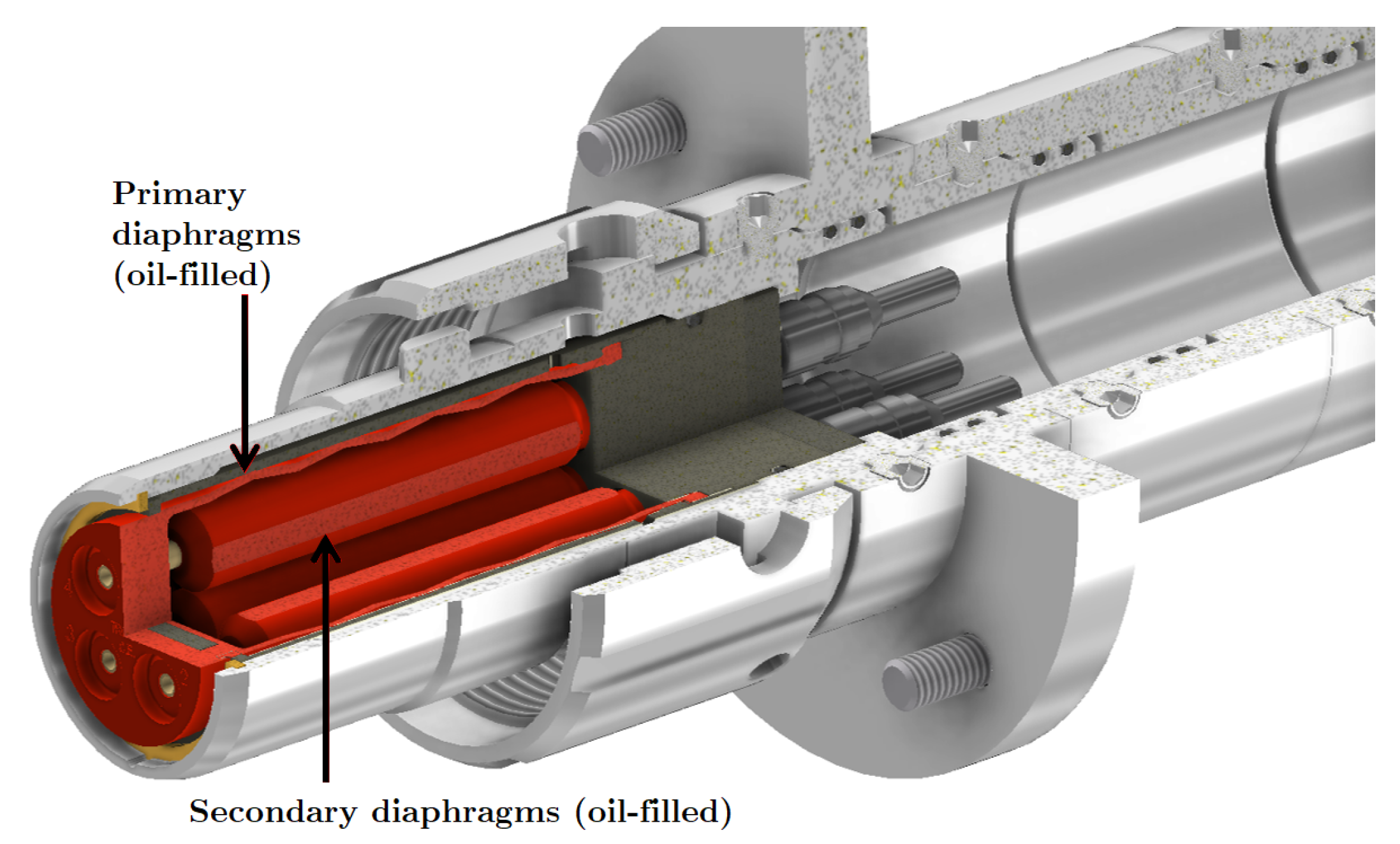
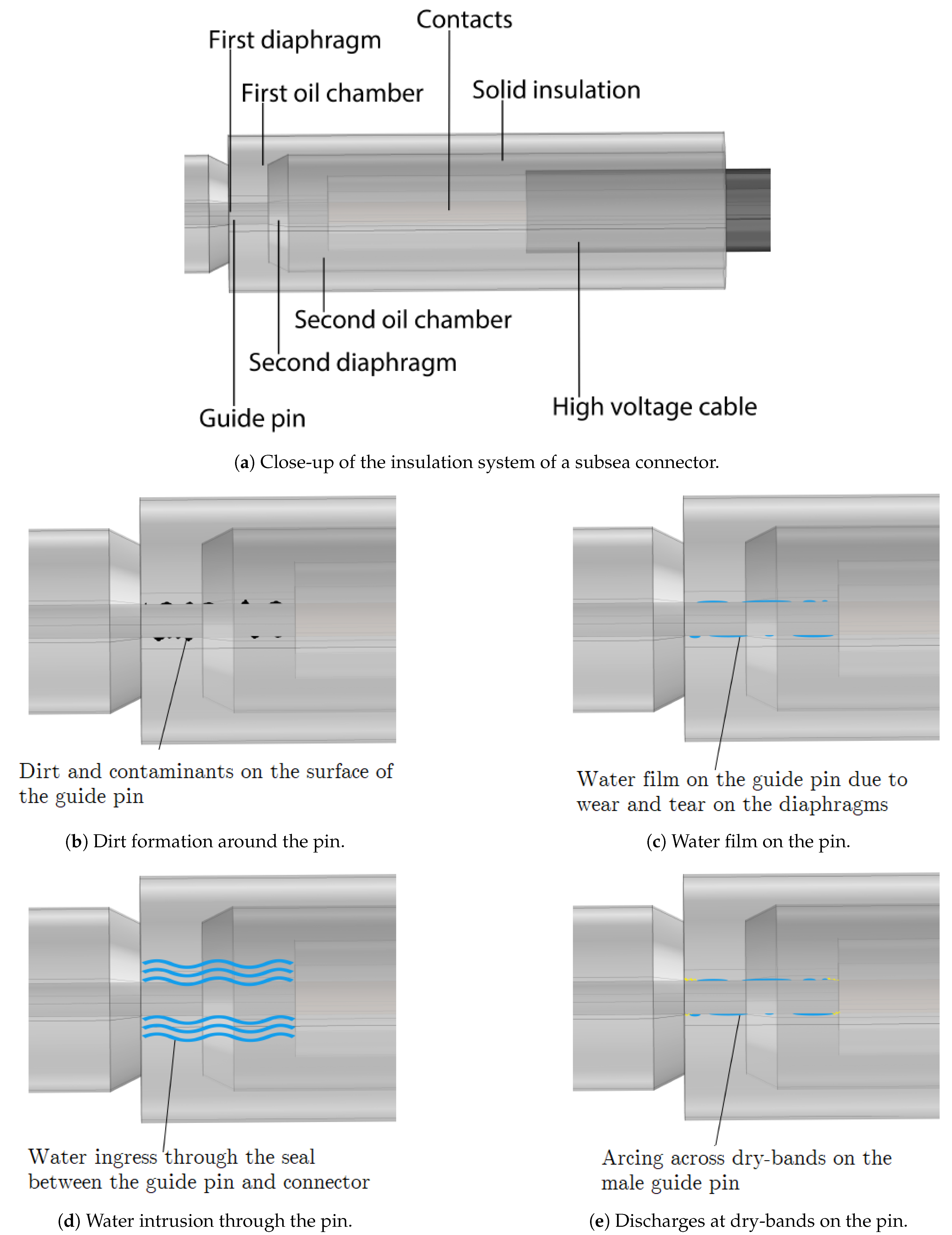



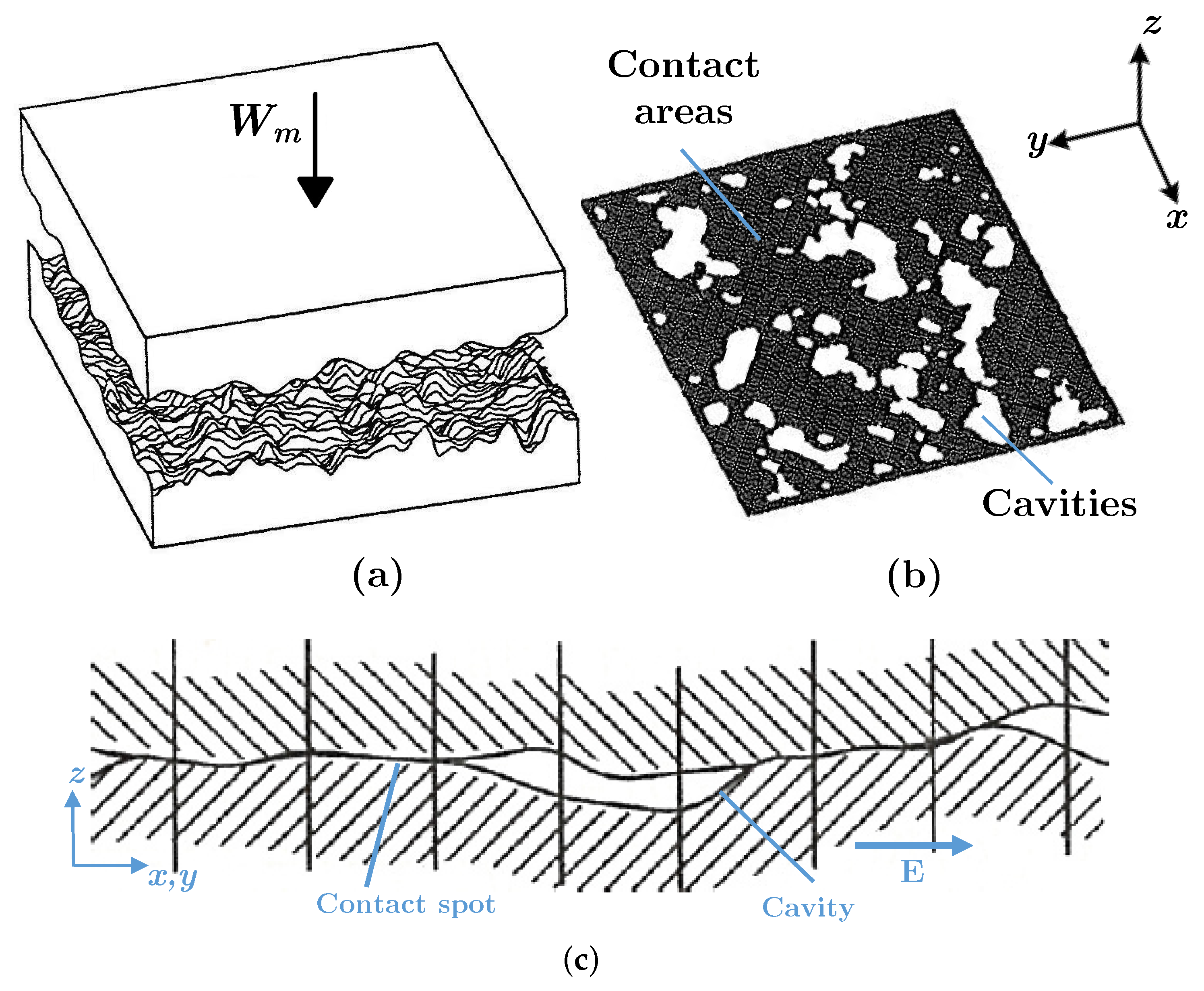
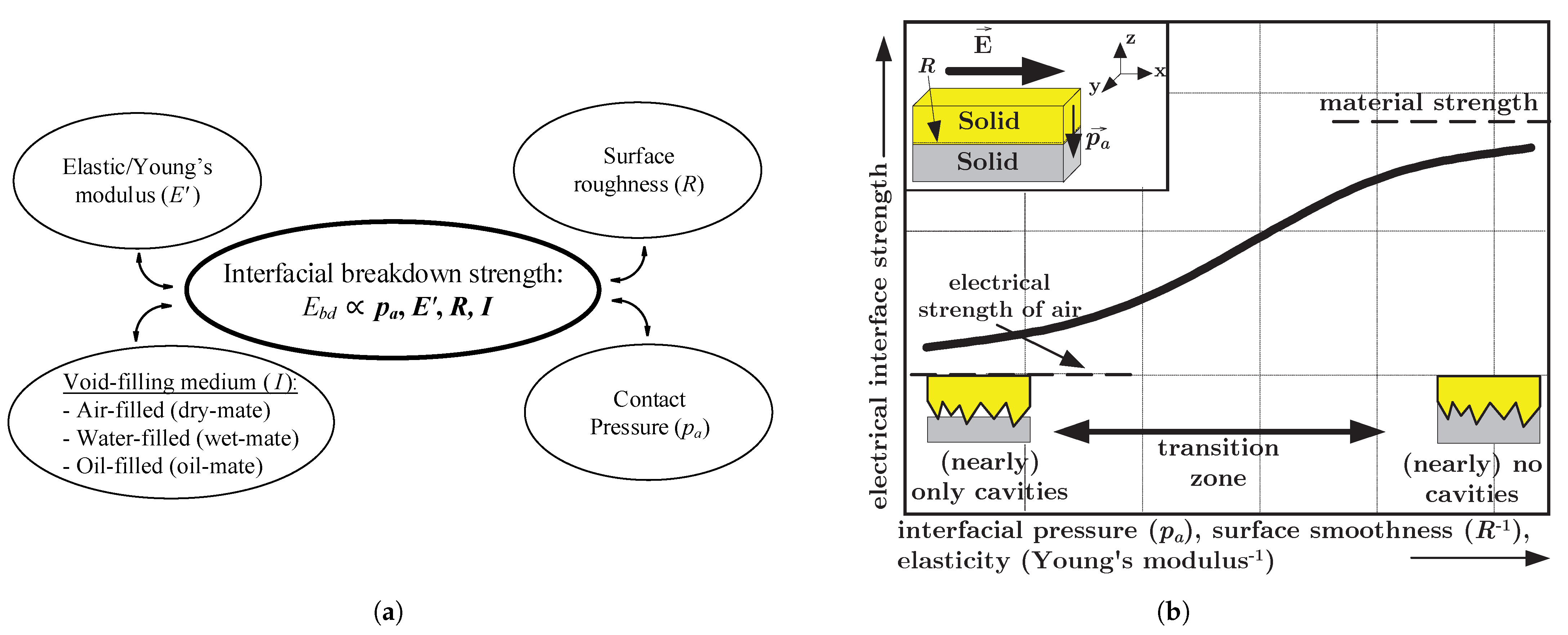
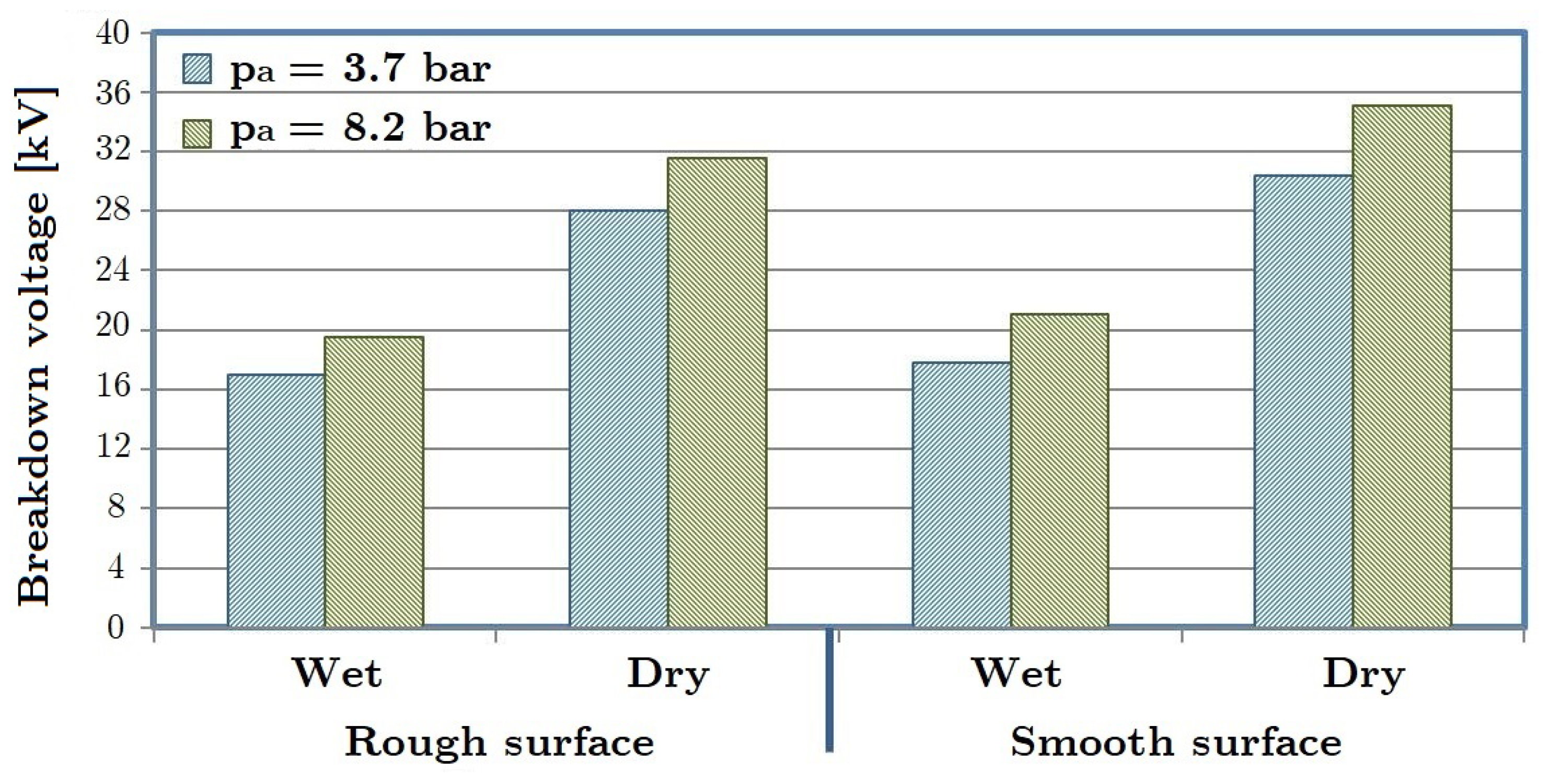
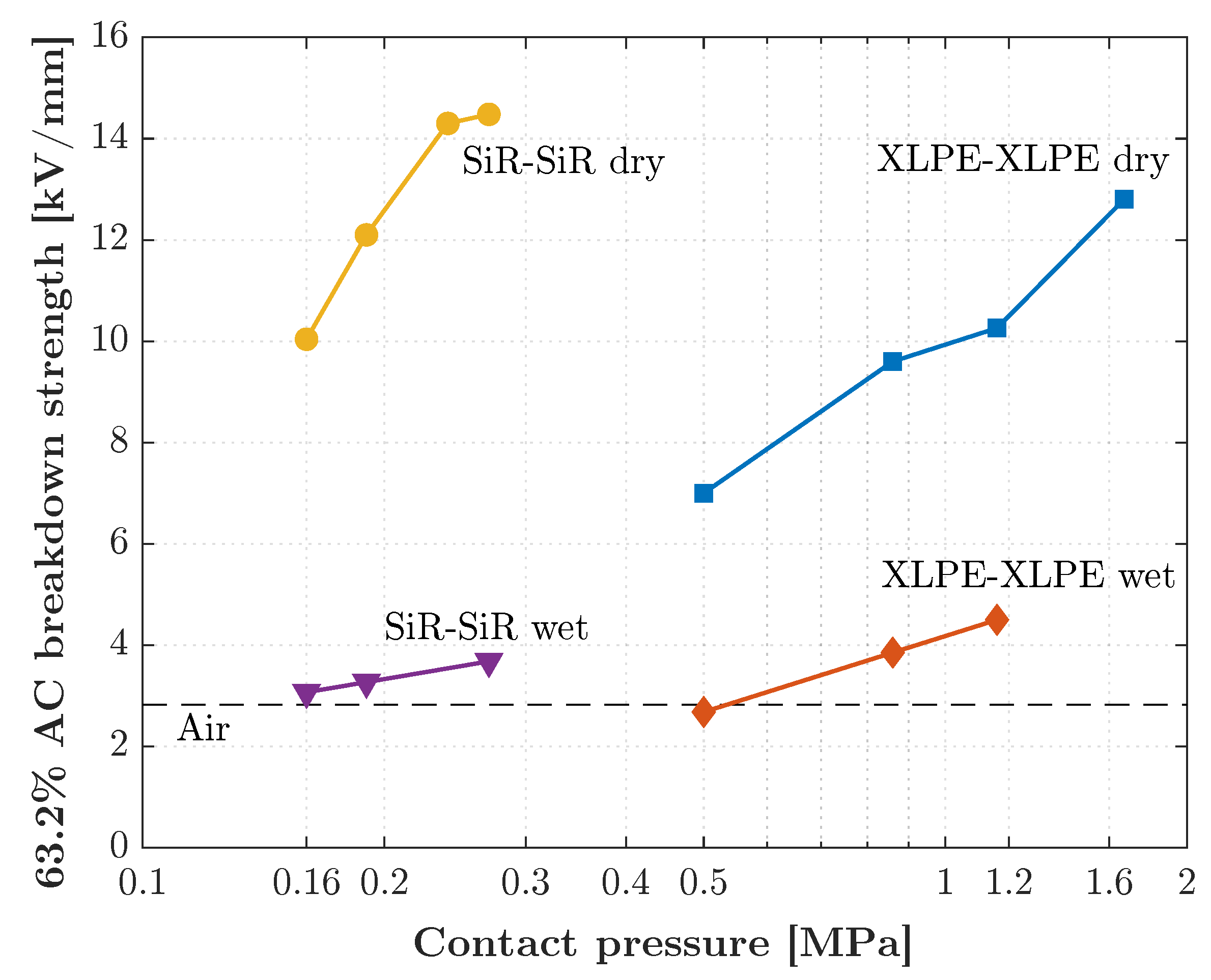
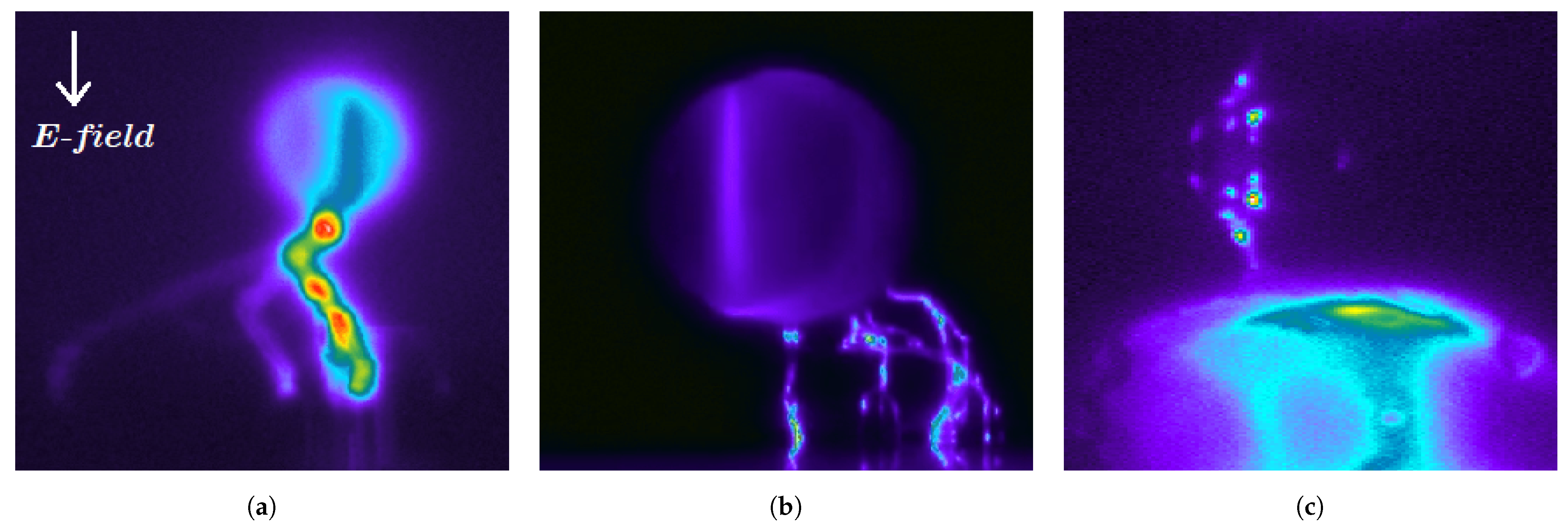

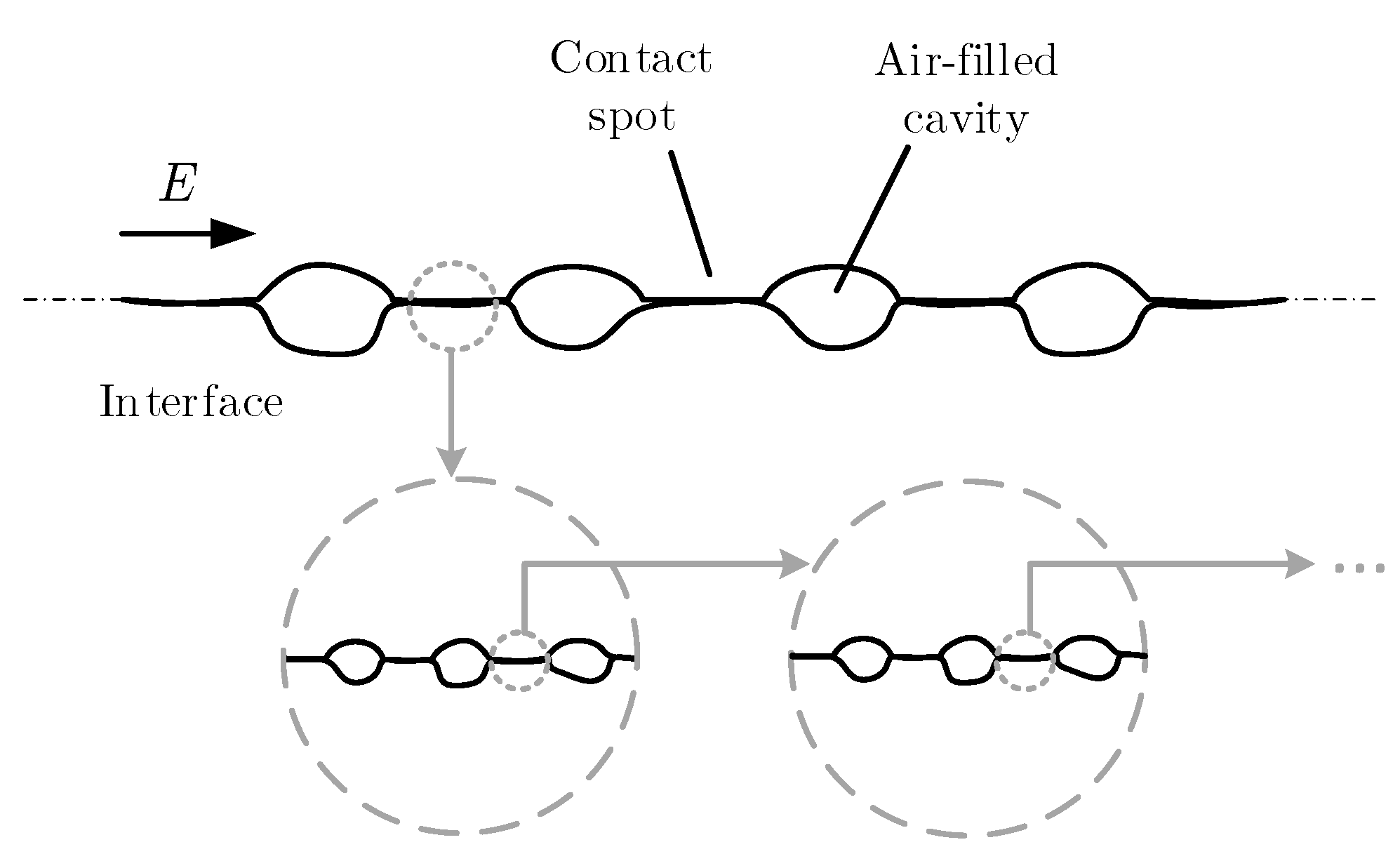
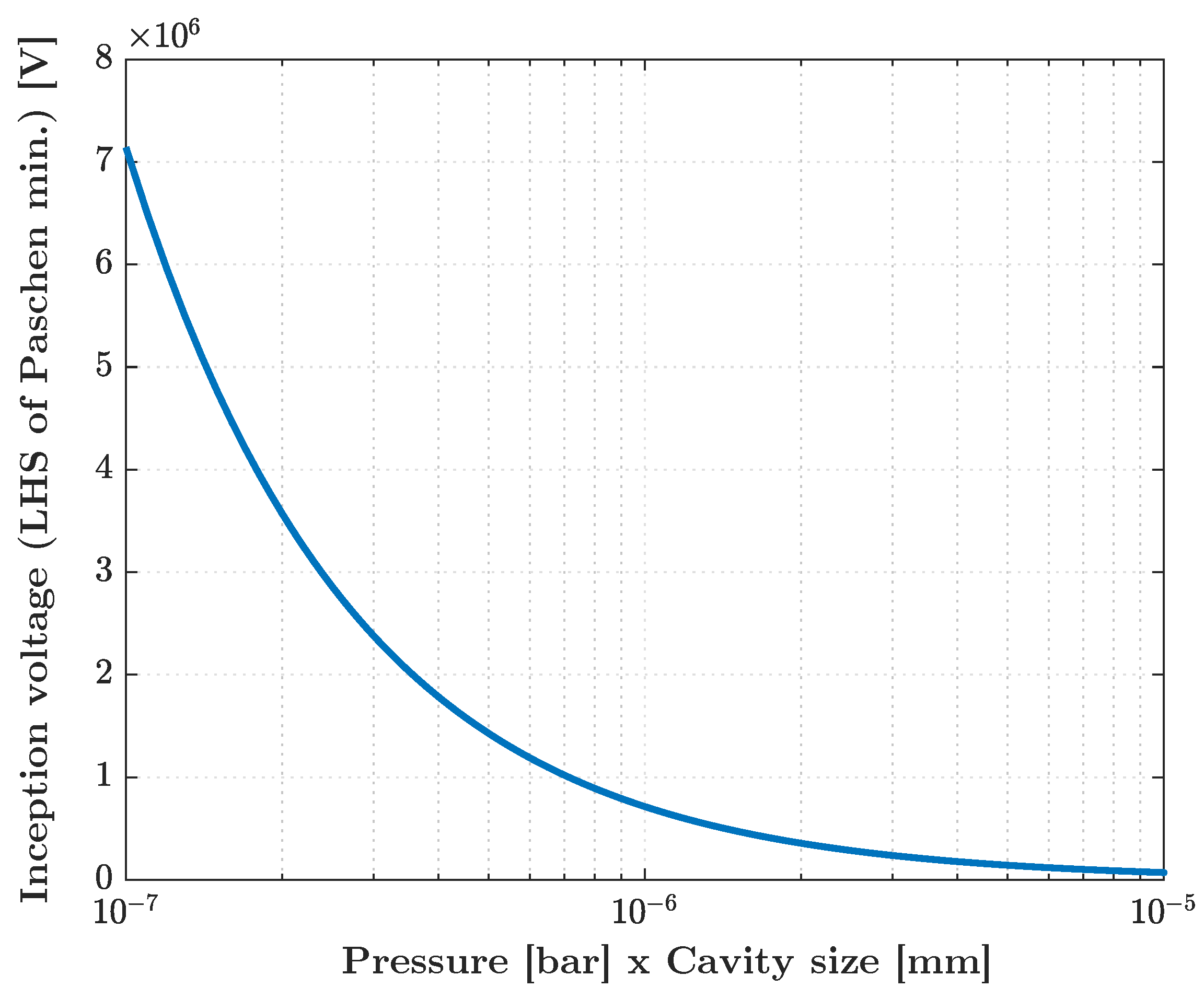


| XLPE–XLPE Interface | |||
|---|---|---|---|
| Contact Pressure | SiR–SiR | XLPE–XLPE | EPOXY–EPOXY | PEEK–PEEK | ||||
|---|---|---|---|---|---|---|---|---|
Publisher’s Note: MDPI stays neutral with regard to jurisdictional claims in published maps and institutional affiliations. |
© 2021 by the author. Licensee MDPI, Basel, Switzerland. This article is an open access article distributed under the terms and conditions of the Creative Commons Attribution (CC BY) license (https://creativecommons.org/licenses/by/4.0/).
Share and Cite
Kantar, E. Dielectric Strength of Polymeric Solid–Solid Interfaces under Dry-Mate and Wet-Mate Conditions. Energies 2021, 14, 8067. https://doi.org/10.3390/en14238067
Kantar E. Dielectric Strength of Polymeric Solid–Solid Interfaces under Dry-Mate and Wet-Mate Conditions. Energies. 2021; 14(23):8067. https://doi.org/10.3390/en14238067
Chicago/Turabian StyleKantar, Emre. 2021. "Dielectric Strength of Polymeric Solid–Solid Interfaces under Dry-Mate and Wet-Mate Conditions" Energies 14, no. 23: 8067. https://doi.org/10.3390/en14238067






